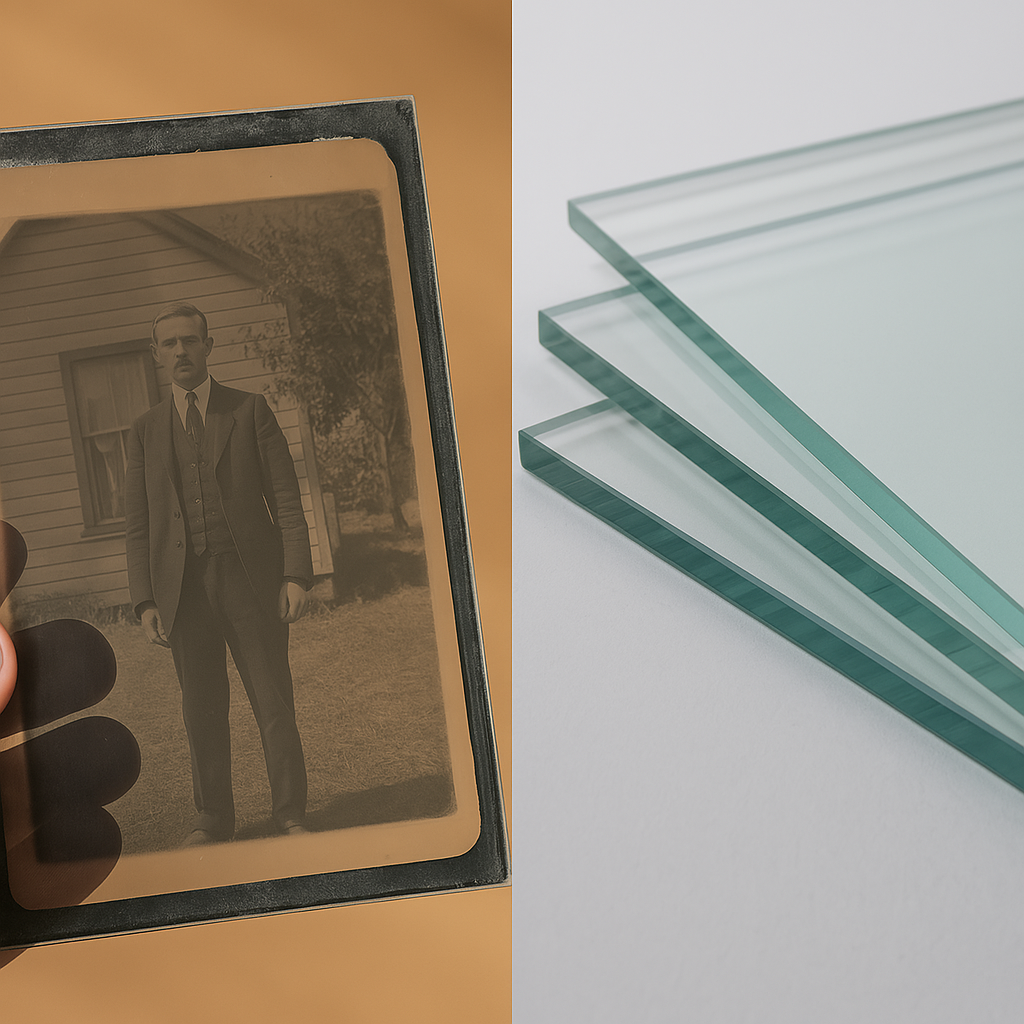The evolution of glass technology, particularly from historic glass plate negatives to modern float glass, illustrates remarkable advancements in material science and manufacturing processes. Both types of glass played pivotal roles in shaping their respective eras, impacting industries such as photography, architecture, and automotive manufacturing. In this article, we explore how the journey from glass plate negatives to today’s sophisticated float glass has transformed the glass industry.
What Are Glass Plate Negatives?
Before delving into the transition to float glass, it’s essential to understand what glass plate negatives are and their historical significance.

History of Glass Plate Negatives
Glass plate negatives emerged in the mid-19th century with the advent of photography. Invented by Frederick Scott Archer in 1851, the wet plate collodion process revolutionized photography, allowing high-quality, detailed images. Photographers coated clear glass plates with a light-sensitive emulsion, capturing images with remarkable precision and clarity.
By the late 19th century, the introduction of dry glass plates further simplified photographic processes, making photography more accessible by eliminating the need for immediate processing.
Manufacturing and Use of Glass Plate Negatives
Creating glass plate negatives involved a meticulous, multi-step process:
- Cleaning and preparing clear glass plates thoroughly
- Applying a thin emulsion layer made of silver halides suspended in gelatin
- Exposing the emulsion-coated plate to capture the image
- Developing, fixing, washing, and drying the plate to preserve the photographic image permanently
Photographers favored glass plates due to their durability and clarity, although their heavy and fragile nature posed logistical challenges.
Limitations and Decline of Glass Plate Negatives
Despite their excellent image quality, glass plate negatives had limitations:
- Fragility and cumbersome handling
- Heavy, bulky storage requirements
- Labor-intensive processing and high production costs
These drawbacks ultimately paved the way for lighter, more practical photographic films and digital photography, marking the decline of glass plates in mainstream photography.
The Rise and Importance of Float Glass
From the foundation laid by historical glass plate negatives, the glass industry evolved significantly. The introduction of float glass in the mid-20th century marked a revolutionary change, providing glass of unprecedented clarity, smoothness, and uniform thickness.
What is Float Glass?
Float glass is high-quality flat glass produced by floating molten glass on a bed of molten tin. This innovative process, developed by Sir Alastair Pilkington in the 1950s, replaced older techniques that required extensive grinding and polishing, offering superior quality glass at lower production costs.
Today, float glass is ubiquitous, used in architecture, automobiles, solar panels, furniture, and various decorative applications.
Float Glass Manufacture Process
The modern float glass manufacture involves several precise, automated stages:
- Batch Preparation: Mixing raw materials like silica sand, limestone, soda ash, and recycled glass.
- Melting and Refining: Heating the materials at approximately 1,500°C to form molten glass.
- Float Bath: The molten glass floats over molten tin, ensuring consistent thickness and smooth surfaces.
- Annealing: Controlled cooling reduces internal stress, enhancing durability.
- Cutting and Inspection: Glass sheets are trimmed, thoroughly inspected, and packaged.
This streamlined manufacturing process results in superior-quality, affordable clear float glass, making it accessible for broad industrial and commercial applications.
Comparing Glass Plate Negatives and Float Glass
The shift from historic glass plate negatives to modern float glass signifies considerable advancements in glass technology and production methods, enhancing functionality, quality, and versatility.
Differences in Manufacturing Techniques
- Glass Plate Negatives: Hand-prepared plates, manually coated and developed, requiring precise chemical processes and meticulous handling.
- Float Glass: Highly automated, continuous manufacturing process, resulting in uniform, high-quality, cost-effective glass.
Material Quality and Properties
Both glass types prioritize clarity and durability, but float glass achieves consistent uniformity, superior flatness, and greater versatility, ideal for structural and architectural use.
Applications and Usage
- Glass Plate Negatives: Historically significant in photography for capturing detailed images but limited in practical use today due to fragility and cumbersome processing.
- Float Glass: Extensively used in architecture, automotive manufacturing, interior design, and renewable energy applications, underscoring its versatility and practicality.
Float Glass Industries Worldwide: Emirates and Mediterranean Examples
Global float glass industries exemplify modern advancements and regional growth, particularly in areas like the UAE and the Mediterranean.
Emirates Float Glass Industry
Emirates Float Glass, located in the UAE, is renowned for advanced glass manufacturing techniques, sustainable production practices, and high-quality products. UAE’s strategic location, modern infrastructure, and commitment to innovation position it as a significant global player in float glass production.
Mediterranean Float Glass Industry
Similarly, Mediterranean float glass manufacturers, including prominent names like Saint-Gobain, Guardian Glass, and Şişecam, represent key players in the global float glass market. Their high-quality products and innovative solutions cater to European, African, and Middle Eastern markets, reflecting the industry’s global interconnectedness and competitive strengths.
Modern Applications and Innovations in Float Glass
Today’s float glass technology continues to evolve, meeting contemporary demands in various sectors:
Architectural Applications
In architecture, float glass is critical for windows, façades, skylights, and internal partitions, offering excellent transparency, insulation, and aesthetic flexibility.
Automotive Glass Solutions
Automotive manufacturers rely on clear float glass for windshields, side windows, and mirrors, prioritizing clarity, safety, and durability.
Solar and Renewable Energy
The renewable energy industry heavily uses float glass, specifically formulated for photovoltaic panels, significantly enhancing solar efficiency and durability.
Decorative and Interior Uses
Float glass is extensively applied in interior designs, furniture, mirrors, decorative partitions, and glass accessories, emphasizing versatility, aesthetics, and functionality.
Future of Float Glass: Sustainability and Technological Innovations
Sustainability and innovation drive the future of float glass manufacturing:
Environmental Sustainability Initiatives
- Recycling initiatives and waste reduction
- Energy-efficient manufacturing processes
- Eco-friendly glazing solutions for buildings
Smart Glass Technology
Innovations in smart glass technology, including electrochromic and switchable glass, allow control of transparency, enhancing energy efficiency, privacy, and user comfort.
Advances in Solar Glass
Improvements in solar glass technology boost renewable energy efficiency, emphasizing float glass’s vital role in sustainable energy solutions.
Conclusion: From Glass Plate Negatives to Float Glass
The journey from historical glass plate negatives to contemporary float glass demonstrates transformative advancements in glass technology. While glass plate negatives significantly impacted photography and historical documentation, float glass revolutionized multiple industries, demonstrating unmatched versatility, quality, and innovation.
Continued technological advancements, sustainable practices, and global market growth ensure float glass remains integral to future developments across architectural, automotive, renewable energy, and interior design sectors.

